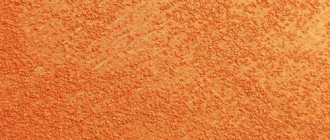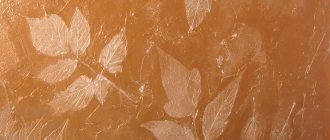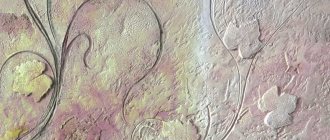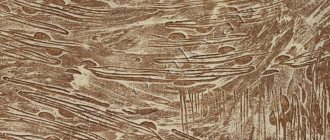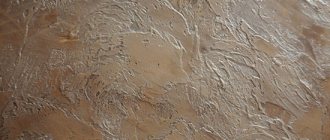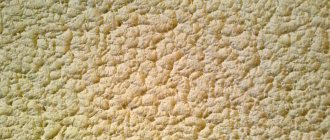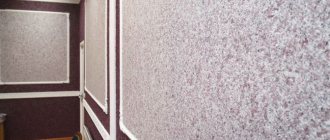Not everyone knows what Venetian paint is, but every person has made renovations to their home at least once in their life. For some it becomes a habit. People see no obstacles to frequently making minor repairs or spontaneously deciding to make a major interior change. Some people make repairs out of necessity, others do it for originality and to demonstrate their wealth. One way to do this is the Venetian. Today, painting walls in this way is very popular and in demand.
For information
One of the most important things in renovation is wall decoration. Just a few decades ago, people could not even think that something special could be done with the walls in their house. The most common method of repair was whitewashing (painting) or wallpapering the walls and ceiling.
Decorative putty has been widely used for quite some time. Wall painting is still used, only with the use of new technologies.
There are several types of wallpaper that are designed separately for the kitchen, bedroom, and there are special types of ceiling coverings. The advantage of decorative putty over wallpaper is that it can be used in different rooms.
Time does not stand still. Every year, new possibilities are invented in construction, which allow not only to create comfort and beauty, but also to stand out from the background of primitive solutions, expanding their capabilities.
A recent invention in the construction industry is decorative plaster. Recently, it has become very popular and has almost replaced primitive wallpaper. Unlike walls covered with wallpaper, decorative plaster makes it possible to convey a variety of colors, play of colors and original ideas. Hypoallergenic building materials that are safe for health are used. They are practical and durable.
This putty is ideal for any room, as it is durable, original and multifunctional.
What is "Venetian"
Venetian plaster is a decorative mixture used for finishing interior walls. It may include marble, granite, quartz or other natural stone chips, as well as a latex or acrylic binder component.
To achieve an attractive finish that imitates marble, several tones of plaster are used and applied on top of each other. The more layers, the deeper the color will be, and the more expressive the texture will be.
Venetian wall painting
The coating, which was used by architects to decorate palaces and temples in ancient times, is called Venetian. This is a type of decorative plaster. This kind of wall covering was considered expensive, and only wealthy people could afford it. The masters did not reveal their skills to a wide range of people, but passed on their knowledge from generation to generation.
Venetian stain is a marble imitation that is used for walls and fireplaces. Today, Venetian plaster is available to a wide range of people. The color range makes it possible to choose a shade for any interior. You can choose between matte and glossy finish. There are 2 types of Venetian - external and internal.
This method of wall decoration gives the room sophistication and uniqueness. In order for the Venetian to look beautiful on the walls, it must be applied correctly. This requires experience and knowledge. Craftsmen who know exactly the intricacies of working with Venetian plaster charge a considerable amount of money for painting work, while the materials themselves are not cheap.
The interior decoration with Venetian plaster looks very beautiful on the walls and fits perfectly into any interior. The technology is already used all over the world. It not only adds originality to wall decoration, but is also a stylish solution for renovation.
Pros:
- Venetian plaster is an environmentally friendly product. During operation and operation it does not pose a threat to health.
- Walls covered with Venetian plaster will delight the eye for many years.
- This coating can minimize visual defects and cracks on the walls.
- Increased moisture resistance.
- Easy to clean.
- You can easily restore or change the color scheme.
- The guarantee for Venetian plaster on walls is up to 10 years.
- Elegance and sophistication, reliability and durability.
Minuses:
- High cost of materials and work of craftsmen.
- Long and thorough preparation of walls for applying Venetian paint. Behind the simplicity of application lies insidiousness: you need to correctly create the surface relief.
Venetian plaster contains marble, quartz and granite dust.
Styles:
- Retro. Craquelure imitates cracks on the walls, which imitates antiquity. This effect is achieved by applying a special varnish to the surface. a unique style is created.
- Marble. Play of shades on the surface. This is a very painstaking job that requires attention, since different shades are applied to the wall about 10 times.
- Marseille wax. Ordinary plaster with the addition of wax. It is distinguished by its water resistance.
Photo: colors and interiors
Imitation of Venetian plaster in the interior can have different colors. The following tone options are popular:
Coatings in blue, green and burgundy shades, complemented by gold patterns, look great. When simulating natural stone, veins of black, ultramarine, and maroon paint are added.
“Venetian” is suitable for baroque, vintage, and classic styles. Depending on the color scheme, you can beautifully decorate the interior of any room - bedroom, living room, bathroom.
As you can see, Venetian plaster can have a variety of shades, even if it is an imitation of paint.
Do-it-yourself Venetian plaster application
Venetian plaster can be purchased at almost any hardware store. Today it is popular among consumers. There are narrow-profile stores where all kinds of colors are presented.
If a choice has been made and the necessary material has been purchased, you can begin to work. For this difficult task you will need practice in working with plaster. It is not a fact that you will get a work of art the first time. But it is important to take into account that before working with difficult material, you need to at least watch video tutorials on how to do it, or be present when a master works. It is also important to adhere to the time scale (drying time for each layer).
As for the tools, you will need rollers, brushes, brushes, spatulas, a Venetian trowel, sponges, paper, stencils, fabric, sandpaper and sanded bars. Quite a considerable arsenal, but if you have to do repairs on your own more than once, then all this will definitely come in handy. Also, in the process of work, some masters experiment, resulting in an original design. You can create additional effects, such as veining or shine.
Before starting work, you need to decide what type of plaster to use - acrylic or lime. You should pay special attention to the quality of the mixture and its texture, and also buy only paint tested by professionals.
The walls must be prepared in advance; they must be perfectly smooth, without flaws. It is necessary to remove the remnants of old wallpaper or previous coating. In order for the work with putty to be of high quality and not problematic, and for the painting to last for many years, you need to remove dust and dirt from the surface and prime the walls.
Venetian plaster is applied in several passes. Each color must dry for the next coat to adhere well. Afterwards the wall is polished. The next stage is waxing. This process takes quite a long time.
Useful tips
To guarantee success in working with Venetian plaster yourself, it is useful to pay attention to some nuances:
- Make sure that you have chosen a truly suitable finishing method. The usual Internet request “ Venetian plaster photo in the interior” or “Venetian plaster for interior wall decoration photo” completely solves the external part of the problem. The other side of the coin is the correspondence of the features of this technique to the specifics of the room, its purpose and conditions.
- It is important to study the technique in theory, watch video master classes and consult with those who already have experience in similar activities.
- Before starting large-scale work, it is useful to practice applying Venetian paint on a small area of the surface - on a piece of drywall or on a wall in the workshop.
- The key point is keeping utensils, tools and your own hands clean. Mixing putty shades at a time when this was not planned can ruin the entire effect. The same applies to the influence of dust and dirt.
- Since finished plaster can form sediment, it is worth stirring the composition periodically during work to avoid the appearance of layers.
- For all methods of applying Venetian plaster, the recommendation is to periodically change the direction of work, and if several experts are involved in the process, they should change places. This will avoid unnecessary zoning of the surface according to the direction or shape of the pattern.
Oil paint coating technology
Walls for finishing must be prepared in the same way as when working with latex paints. Here are the differences:
- Cover the prepared wall with transparent paint of a slightly pinkish tint.
- After the first layer has dried, apply the second.
- Prepare glaze (translucent) paint.
- Divide the wall (mentally) into strips of short length (10 centimeters).
- Using a medium-sized paint brush, apply stripes of paint to the wall.
- Rub the paint onto the wall with a wool rag. The more chaotic the movements, the better.
- Go over the wall with a dry, soft-bristled brush. This will help blend the paint well.
- Wait until the surface is completely dry.
To prepare glaze paint you will need linseed oil, turpentine + drier (you need to add just a couple of drops of drier to turpentine), oil paint (tube). The ratio of linseed oil and diluted turpentine is 1:2. Mix the ingredients until a homogeneous composition is obtained. Add half a tube of oil paint and rub until the desired color is uniform.
Choose a shade such that the imitation of Venetian is as close as possible - light ocher, natural sienna, umber, brown mineral pigment (natural clay). The last two shades will help create a mixture that perfectly imitates natural marble, right down to the veins.
Using latex or glaze paints, without spending much effort, you can imitate Venetian plaster on the walls and ceiling of your home. It is important to choose the right ratio of colors and their shades. The paint does not have the effect of depth, this quality is characteristic only of the Venetian. Therefore, it depends on the chosen color whether the room will visually increase or, on the contrary, decrease.
For the walls of a small dark room, choose light shades; they can be combined with silver. In a large sunny room, you can use rich green, blue, apricot, burgundy colors in combination with a warm sand or pale yellow base. To add a luxurious effect, apply a golden pattern to the walls. For ceilings, the best solution would be to imitate a sunset (gradient fill) or a blue sky with white clouds.



